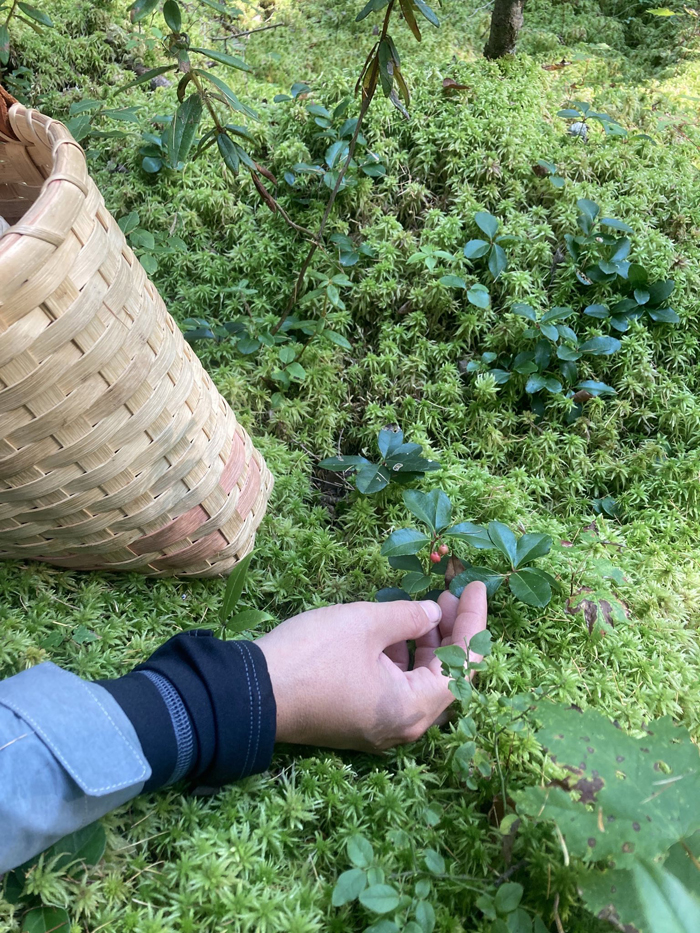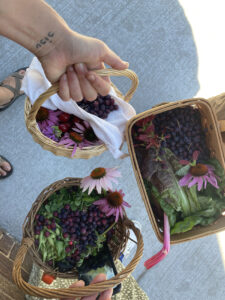Foraging provides time outdoors, food for the kitchen

By Rick Cohler
Contributing Writer
GREEN BAY – A walk in the woods is not only good exercise, but one can also find berries, herbs and other edible plants if you know where to look.
That’s the goal of Crystal Brown, owner of Inspired North in Green Bay.
Brown is an ethnobotanist educator and writer focusing on wild edible food, medicinal plants and fungi and offers educational tours and excursions in area parks and woodlands throughout the season.
She holds a bachelor’s degree in nursing from the University of Wisconsin-Green Bay and has a background working as a psychiatric mental health registered nurse with children, adolescents and adults and experiences working with trauma-informed care.
Growing up, Brown spent a lot of time outdoors at her grandmother’s home in northern Wisconsin and during a sabbatical from her job decided to get back out into nature.

“I became healthier,” she said. “I was learning more about plant medicine and wild food. I started to shift my diet and activity level and I just felt better.”
Some of her teachers of wild food and medicine include authors Samuel Thayer, Tom Elpel, Darcy Williamson and Nick Vander Puy.
During a walk through He-Nis-Ra Park on Green Bay’s west side, the first plant to catch her attention was a shoot of nettles.
Most people avoid the stinging plant, but it has its uses.
The leaves from spring shoots can be sautéed or used for tea, she explained.
The adult leaves can also be used to stimulate feeling.
“If a patient has surgery and they don’t have feeling in their skin, they can use it,” she said. “It can also be used to treat arthritis.”
The next plant to crop up on the walk was a raspberry shoot.
In spring, the leaves can be used to brew a tasty tea and fresh wild raspberries are hard to beat.
Brown pointed out that there is a long list of healthful wild plants.
“My favorite is bee balm or wild bergamot. I use it as a tea because it has anti-viral qualities. I love making infused honeys and vinegars with it,” she said.
Ramps, or wild onions and morel mushrooms, are the most popular foraging plants in the spring, but Brown says foragers should be conscious of the impact picking wild plants can cause.
“As foragers, we’re not about wiping out a population; we’re about giving back,” she explained. “There are ways to minimize the impact on the population.”
Other popular foraging plants during spring include morel mushrooms, asparagus, maple sap, Virginia waterleaf, garlic mustard, pheasant back mushrooms and ostrich ferns.
Summer plants include berries, chanterelle and oyster mushrooms, medicinal herbs such as pine pollen, bee balm, golden rod, red clover and wild rice.
Fall plants are shrimp of the woods and maitake mushrooms and whitefish.
Winter plants are chaga mushroom, but it is also a good time for scouting for future foraging locations.
Most public land is open to foraging of fruits, nuts and mushrooms, but foragers should check with the unit of government that oversees the land for any restrictions.
Foraging has been used by indigenous people for thousands of years and it’s another reason Brown was attracted to it.
“It helps people build relationships with nature because it is ‘original knowledge’ passed on from generation to generation,” she said. “Food is a unifying source. There is so much loneliness and tension in our current society; so for me, sharing my passion is a way to bring health to people and show them they are part of this sacred creation.
“Learning about a new plant is like making a new friend. You build a relationship over time.”
“After picking my first mushroom I went to great lengths to make sure it was safe to eat. There are plenty of resources to check to be sure, and we can build confidence by small steps.”
For more information, visit inspirednorth.com and https://dnr.wisconsin.gov/wnrmag/2021/Spring/Forage#.
